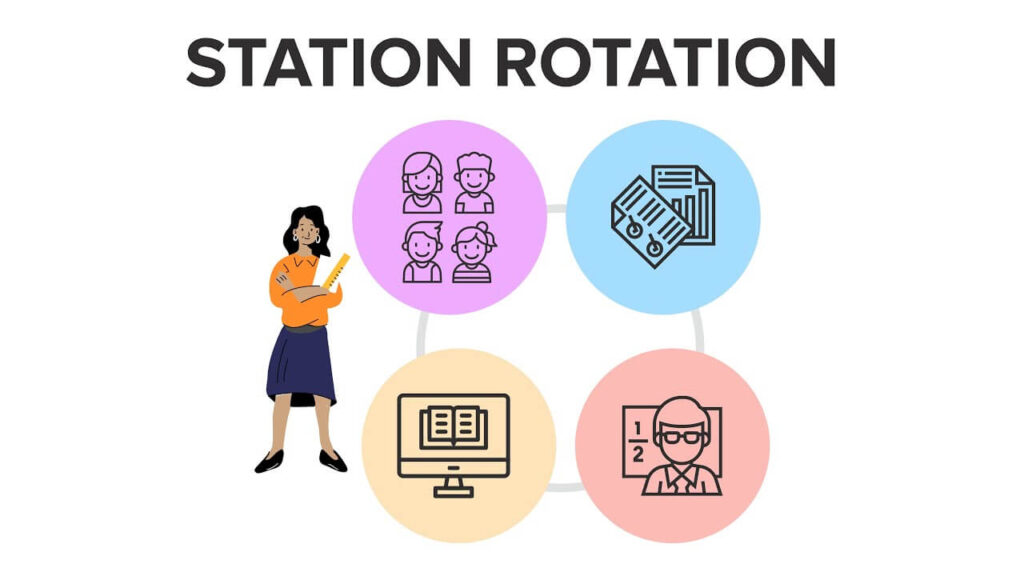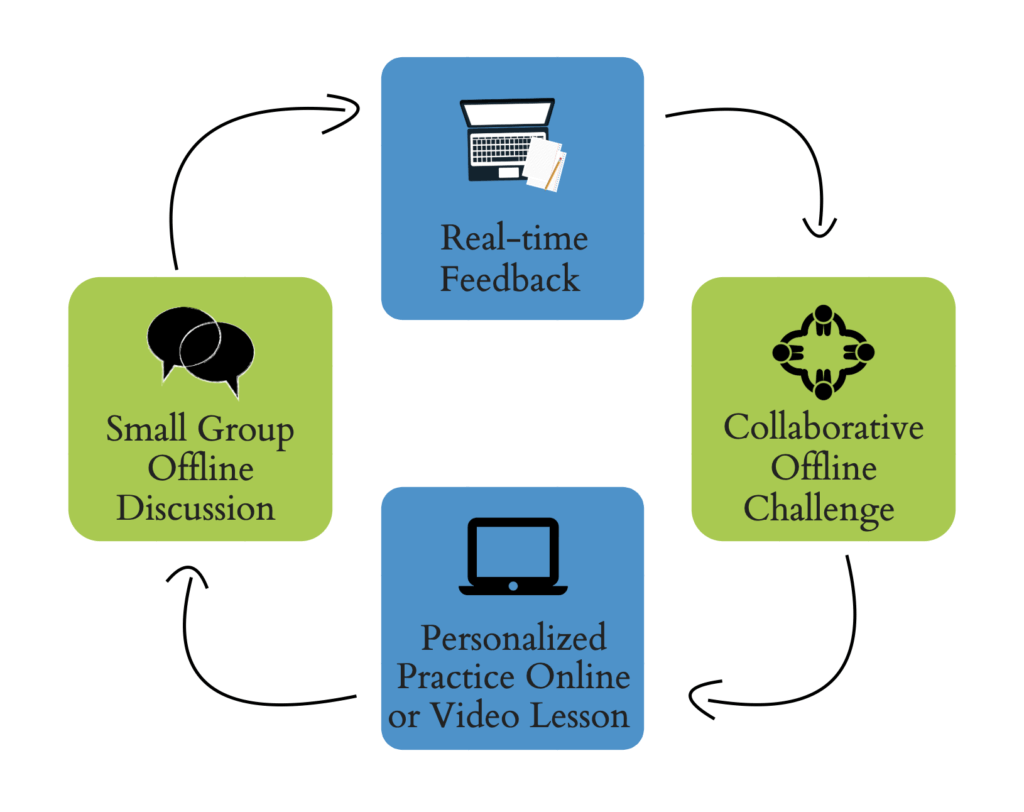In today’s dynamic educational landscape, innovative teaching strategies are continuously emerging to engage students and enhance their learning experiences. One such approach gaining popularity is the Station Rotation Model. This flexible and dynamic method offers educators a powerful tool to individualize instruction, cater to diverse learning needs, and promote active student participation. In this article, VTJ will deeply research what the Station Rotation Model entails, explore its benefits, and discuss how it can be adapted for various grade levels. From there, offer practical advice on implementing this model effectively in your classroom.
What is The Station Rotation Model?

The station rotation model is an instructional framework that transforms traditional classrooms into dynamic learning environments. At its core, it involves dividing the class into smaller groups and rotating them through a series of learning stations during a single class period. Each station is carefully designed to deliver specific content or activities, allowing students to engage with the material in diverse ways. By moving from one station to another, students encounter varied learning experiences, promoting active exploration and a deeper understanding of the subject matter.
Explore More Teaching Tips: 15+ Ways to build confidence in your ESL students
The Benefits of the Station Rotation Model

The station rotation model offers several benefits for both teachers and students. Here are some of the key advantages:
- Personalized Learning: The station rotation model allows for personalized learning experiences. Students can work at their own pace and receive individualized instruction based on their specific needs and learning styles. This approach helps to address the diverse needs of students in the classroom and ensures that each student receives the support they require.
- Differentiated Instruction: With the station rotation model, teachers can differentiate instruction more effectively. By offering a variety of learning stations, each catering to different learning modalities and levels of difficulty, teachers can provide targeted instruction to meet the unique needs of their students. This helps to ensure that all students are appropriately challenged and engaged in their learning.
- Flexibility and Differentiation: The station rotation model is flexible and can be applied to various subjects, allowing teachers to adapt it to the specific needs and requirements of different disciplines. Teachers can design stations to align with specific learning objectives, ensuring flexibility in content delivery.
Discover Related Guides: 4 Types of Learning Styles: How to Use VARK Model in Teaching
Continue Learning: 14 Types of teaching methods for an effective lesson
Different Station Rotations For All Grade Levels
Adapting the Station Rotation Model to diverse grade levels allows educators to tailor instructional strategies to the unique needs and developmental stages of students. Below are three distinct station rotations suitable for all grade levels.
See More Strategies: How To Write a Lesson Plan in 6 Steps: The Complete Guide
Teacher-Led Station

In the teacher-led station, educators take on the role of facilitators, providing direct instruction and guidance to a small group of students. This station allows for personalized attention, targeted support, and the opportunity to address individual learning needs. For younger grades, the teacher-led station might involve interactive storytelling, hands-on demonstrations, and group discussions. In higher grades, it could incorporate more in-depth discussions, project-based learning, or guided explorations aligned with the curriculum. Additionally, teacher-led station serve as invaluable tools for gathering feedback. This feedback is instrumental in personalizing content to cater to the diverse learning styles within your educational community.
Read Another Article: 20+ Effective Classroom Management Strategies and Techniques
Explore More Content: What is blended learning? Types, Examples & Benefits?
Offline Station

The offline station emphasizes hands-on, tactile learning experiences, promoting creativity and collaboration. In this station, students engage with physical materials, manipulatives, or traditional learning resources. In these stations, learning experiences unfold through the exploration of books, manipulatives, journals, and other tactile resources. Students are encouraged to engage in individual reflection on the lesson or express their understanding through illustrations.
View Similar Articles: Practical Tips to Deal with Negative Teacher
Online Station

The online station harnesses the power of technology to deliver digital content, interactive simulations, and web-based resources. This station is particularly relevant in today’s digital age and helps students develop essential 21st-century skills. The integration of technology in stations extends beyond individual learning, fostering group discussions and collaborative projects, even in virtual settings. Video conferencing facilitates class meetings, and digital communication tools enable students to exchange ideas seamlessly. It could incorporate online research, virtual labs, and collaborative projects. The online station not only enhances technological proficiency but also provides access to a wealth of educational resources beyond traditional classroom materials.
See Also This: How to Teach Writing Skills to Students Effectively in 8 Simple Steps
Try This Article: 120+ High and Middle School Debate Topics for Students
How To Use The Station Rotation Model In Your Classroom
The station rotation model is a dynamic and versatile instructional approach that can transform your classroom into an engaging and personalized learning environment. Let’s begin by clearly defining your learning objectives for the lesson or unit. Identify the key concepts and skills you want students to master. Based on your learning objectives, choose station activities that align with the content and skills you are teaching. Develop specific activities for each station that cater to different learning styles and preferences. Ensure that activities are engaging, aligned with your curriculum, and offer opportunities for both individual and collaborative learning.
Incorporating the station rotation model necessitates strategic planning and adaptability. Organize your classroom efficiently, provide clear instructions, and actively engage with students during rotations. Encourage reflection to deepen their understanding and tailor subsequent activities based on their feedback. This iterative process, coupled with ongoing assessments, ensures the model aligns with your educational goals and enhances the overall learning experience.
Explore This Topic: Why Students Get Bored & How to Engage Bored Students in the Class
Incorporating the station rotation model into your teaching repertoire can breathe new life into your classroom. When understanding its principles, benefits, and adaptable station types, you can create a dynamic and engaging learning environment that caters to the diverse needs of your students. Hopefully, this article by VTJ can help you in building effective teaching strategies.
Read This Next: 22+ SMART Teacher Goals Examples in 2025
🌟 Are you facing difficulties in finding and securing teaching positions in Vietnam? Are visa procedures causing you trouble? Feeling overwhelmed and directionless upon your arrival in Vietnam for teaching assignments? Don’t worry, VTJ’s English Teaching Placement in Vietnam (EPIV) Program 2024 provides comprehensive support to solve ALL the matters.
👉👉👉 Click HERE to request free consultation.






